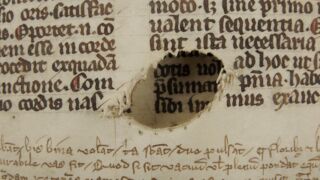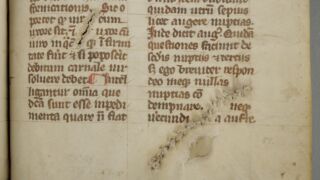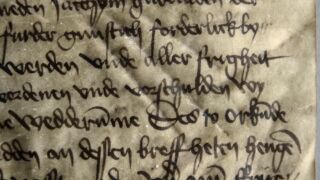A 2. Damages and characteristics resulting from the manufacture of parchment
This category includes the damages and attributes of historical parchments that require documentation, which are related to the manufacture of parchment, are visually discernible and may impact the condition of the parchment.
The damages and attributes in this category:
A 2 damage subcategories:
A 2.1. Holes
A 2.2. Hair remains
A 2.3. Striations
A 2.4. Traces of jagged action
A 2.5. Veining, vein evidence, drainage of blood vessels
A 2.6. Variation in thickness
A 2.7. Opacity, transparency
A 2.8. Splitting
A 2.9. Variation in colour or surface appearance, matte, semi-matte, glossy
A 2.10. Presence of grain layer
Examples:

Ürik TLA.230.1.cm4, 13. saj.
Auk.
Augud võivad tekkida pärgamendi valmistamise kõigis etappides. Lahti rebenenud, algselt kinni nõelutud auk, pärgamendis.

Ürik TLA.230.1.cm4, 13. saj.
Eemaldamata karvkude.
Pärgamendi valmistamisel eemaldamata jäänud karvad.
Pärgamendi õhendamisel tekkinud aukude siseservades võis jääda karvkude koos epidermisega eemaldamata.

Ürik TLA.230.1-i.998, 1528. a.
Kraapimise jäljed.
Kõvera teraga kraabitsa jäljed (vaod, vöödid) pärgamendi pinna.

